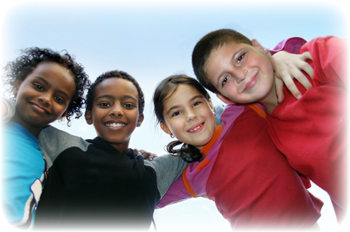



Welcome to Minnesota Milestones 2010! Minnesota Milestones began in 1991 in the belief that a shared vision, clear goals and measurement of results would lead to a better future for Minnesota. The report uses 60 progress indicators to determine whether the state is achieving 19 publicly determined goals. The goals are grouped in four broad areas: People, Community and Democracy, Economy and Environment.
As a starting point, readers are encouraged to read the summary of Minnesota Milestones 2010. The summary provides a brief overview on how Minnesota is progressing toward each goal. Read more about Minnesota Milestones...
Our children will not live in poverty.
1 Child Poverty
2 Low-income School Children
Families will provide a stable, supportive environment for their children.
3 Teen Pregnancy
4 Kids Count Rank
All children will be healthy and start school ready to learn.
5 Low Birth Weight
6 On-time Immunization
7 School Readiness
Minnesotans will excel in basic and challenging academic skills and knowledge.
8 Third-grade Reading
9 11th Grade Math
10 High School Graduation
11 College Readiness
Minnesotans will be healthy.
12 Health Insurance
13 Infant Mortality
14 Life Expectancy
15 Diabetes
16 Obesity
17 Tobacco Use
18 Suicide
19 Index of Well-Being
20 Traffic Injuries and Fatalities
1 Child Poverty
2 Low-income School Children
Families will provide a stable, supportive environment for their children.
3 Teen Pregnancy
4 Kids Count Rank
All children will be healthy and start school ready to learn.
5 Low Birth Weight
6 On-time Immunization
7 School Readiness
Minnesotans will excel in basic and challenging academic skills and knowledge.
8 Third-grade Reading
9 11th Grade Math
10 High School Graduation
11 College Readiness
Minnesotans will be healthy.
12 Health Insurance
13 Infant Mortality
14 Life Expectancy
15 Diabetes
16 Obesity
17 Tobacco Use
18 Suicide
19 Index of Well-Being
20 Traffic Injuries and Fatalities
Our communities will be safe, friendly and caring.
21 Volunteering
22 Violent and Property Crime
23 Homicide Rate
24 Juvenile Apprehensions
All people will be welcomed, respected and able to participate fully in Minnesota's communities and economy.
25 Food Shelf Use
26 Homelessness
27 Employment of People with Disabilities
28 Bias Crimes
29 Voter Turnout
Government in Minnesota will be cost-efficient, and services will be designed to meet the needs of the people who use them.
30 Price of Government
31 Bridges in Good Condition
32 Commute Times
21 Volunteering
22 Violent and Property Crime
23 Homicide Rate
24 Juvenile Apprehensions
All people will be welcomed, respected and able to participate fully in Minnesota's communities and economy.
25 Food Shelf Use
26 Homelessness
27 Employment of People with Disabilities
28 Bias Crimes
29 Voter Turnout
Government in Minnesota will be cost-efficient, and services will be designed to meet the needs of the people who use them.
30 Price of Government
31 Bridges in Good Condition
32 Commute Times
Minnesota will have sustainable, strong economic growth.
33 Growth in Gross State Product
34 Employment of Working-age Population
35 Employment/population ratio
36 Change in Number of Jobs
37 Change in Number of Establishments
38 Unemployment Rate
Minnesota's workforce will have the education and training to make the state a leader in the global economy.
39 High School Education
40 Some College Education
41 College Graduation
All Minnesotans will have the economic means to maintain a reasonable standard of living.
42 Median Household Income Compared to U.S. Median
43 Poverty Rate
44 Average Wage
All Minnesotans will have decent, safe and affordable housing.
45 Home Ownership
46 Housing Costs
47 Foreclosures
Rural areas, small cities and urban neighborhoods throughout the state will be economically viable places for people to live and work.
48 Counties with In-Migration
49 Regional Disparity in Unemployment
50 Income by Congressional District
33 Growth in Gross State Product
34 Employment of Working-age Population
35 Employment/population ratio
36 Change in Number of Jobs
37 Change in Number of Establishments
38 Unemployment Rate
Minnesota's workforce will have the education and training to make the state a leader in the global economy.
39 High School Education
40 Some College Education
41 College Graduation
All Minnesotans will have the economic means to maintain a reasonable standard of living.
42 Median Household Income Compared to U.S. Median
43 Poverty Rate
44 Average Wage
All Minnesotans will have decent, safe and affordable housing.
45 Home Ownership
46 Housing Costs
47 Foreclosures
Rural areas, small cities and urban neighborhoods throughout the state will be economically viable places for people to live and work.
48 Counties with In-Migration
49 Regional Disparity in Unemployment
50 Income by Congressional District
Minnesotans will improve the quality of the air, water and earth.
51 Energy Use per Person
52 Air Quality
53 Greenhouse Gas Emissions
54 Lake water quality
55 Water use
56 Drinking water quality
Minnesotans will restore and maintain healthy ecosystems that support diverse plants and wildlife.
57 Frogs
58 Loon populations
59 Breeding bird populations
Minnesotans will have opportunities to enjoy the state's natural resources.
60 Outdoor Recreation
51 Energy Use per Person
52 Air Quality
53 Greenhouse Gas Emissions
54 Lake water quality
55 Water use
56 Drinking water quality
Minnesotans will restore and maintain healthy ecosystems that support diverse plants and wildlife.
57 Frogs
58 Loon populations
59 Breeding bird populations
Minnesotans will have opportunities to enjoy the state's natural resources.
60 Outdoor Recreation





